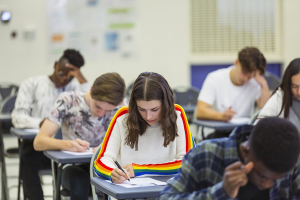Romney's Poll Numbers, 'Favorability' Among Likely Voters Continue to Rise
After the GOP and Democratic conventions had adjourned by early September, the Romney campaign was growing increasingly concerned about the polling differences that separated them and President Obama. Now after two presidential debates and with Americans starting to pay serious attention to which candidate they're actually going to vote for, Romney's chances are looking better by the day.
The average net favorability for Romney in seven post-debate polls has increased to 5.4 percent with Obama's lagging behind at 5 percent.
On April 1 of this year, the Real Clear Politics average of all major polls showed Obama with a solid lead over Romney, 47.7 percent to 43 percent. Although Romney gained some ground by mid-summer, he fell back to the numbers by Aug. 12, before pulling within .7 percent of Obama at the close of the GOP convention in Tampa. President Obama widened the gap to four points by the end of September.
Then came the first debate on Oct. 3. Six days later, Romney had taken a slight lead of less than one percentage point for the first time this year.
On the day of the first debate, political analyst Kyle Kondik of the University of Virginia's Center for Politics told The Christian Post that he thought Romney had been shoring up support among the GOP base but had not effectively picked up any new support, especially among women or minority voters.
"Romney may be in a similar position that John Kerry was in during the 2004 race when he did okay in the debates but couldn't tie things up in the end," he said.
When asked if he felt Romney could move the needle with a solid performance in the first debate, Kondik was less optimistic. "I don't know. We'll see," Kondik said. "He needs to not only move his numbers up but also Obama's down. I need to see him break even in the RCP [Read Clear Politics] average."
And that happened, but the remaining question is where does the race go from here?
In their weekly Crystal Ball column, Kondik and colleagues Larry Sabato and Geoffrey Skelley suggest that one of three scenarios could be playing out: a Romney surge, a narrow victory for Obama or Romney winning the popular vote but with an electoral college tie that would give Romney the presidency, assuming the House of Representatives is still controlled by the Republicans.
"The president won the [second] debate over Romney, although it was not nearly as decisive as the challenger's win in Denver," wrote the trio in their Oct. 18 report. "Romney got his shots in too, although he also stumbled at times and did not land an effective punch on the president during their exchange on Libya. Of course, Romney will get another shot at pressing Obama on foreign policy at the final debate. Given the questions asked during this town hall debate – they were mainly focused on domestic policy – one has to wonder how much voters actually care about the foreign policy topics that will be discussed in further depth next week."
"Given the race's ups and downs, we wonder whether we're still in the third stage of the campaign – the Romney surge – or whether we're back in the first phase of the campaign: a narrow Obama edge. Or could we be in a fourth, 2000-like stage – meaning a freakishly close election?"
Another example of a Romney surge is seen in a Quinnipiac University Poll released on Tuesday that shows Romney closing in on Obama in the traditionally Democratic state of Pennsylvania.
In late September, Obama held a solid 54-42 percent lead by independent voters in the Keystone state. Since the two presidential debates, Romney has dramatically cut that lead and now trails Obama by only four points, 50-46, among likely voters. He leads among men, white voters and white Catholics.
"Gov. Mitt Romney is coming on strong in the Keystone State, especially among white Catholics," said Tim Mallory, assistant director of Quinnipiac University Polling Institute, in a statement on Tuesday. "Pennsylvania voters say Vice President Joseph Biden, a native son and a Catholic, won the debate and is more qualified than Rep. Paul Ryan to be president. But that doesn't seem to be lifting the top of the ticket."
In the same poll, Romney's favorability rating (favorable versus unfavorable) was 46-44 percent which is viewed as a positive given the state's strong Democratic ties. President Obama's favorability rating among likely voters is 52-45 percent.
Another recent poll taken in Wisconsin shows the two candidates in a virtual tie with Obama leading 49-48 percent, but well within the margin of error. Just two weeks ago, Obama led Romney 53 to 42 percent.




























